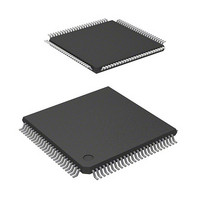DF2170BVTE33V Renesas Electronics America, DF2170BVTE33V Datasheet - Page 250

DF2170BVTE33V
Manufacturer Part Number
DF2170BVTE33V
Description
IC H8S/2170 MCU FLASH 100-TQFP
Manufacturer
Renesas Electronics America
Series
H8® H8S/2100r
Datasheet
1.DF2170BVTE33V.pdf
(572 pages)
Specifications of DF2170BVTE33V
Core Processor
H8S/2000
Core Size
16-Bit
Speed
33MHz
Connectivity
SCI, USB
Peripherals
DMA, POR, PWM, WDT
Number Of I /o
76
Program Memory Size
256KB (256K x 8)
Program Memory Type
FLASH
Ram Size
32K x 8
Voltage - Supply (vcc/vdd)
3 V ~ 3.6 V
Oscillator Type
External
Operating Temperature
-20°C ~ 75°C
Package / Case
100-TQFP, 100-VQFP
For Use With
HS0005KCU11H - EMULATOR E10A-USB H8S(X),SH2(A)3DK2166 - DEV EVAL KIT H8S/2166
Lead Free Status / RoHS Status
Lead free / RoHS Compliant
Eeprom Size
-
Data Converters
-
Available stocks
Company
Part Number
Manufacturer
Quantity
Price
Company:
Part Number:
DF2170BVTE33V
Manufacturer:
Renesas Electronics America
Quantity:
10 000
- Current page: 250 of 572
- Download datasheet (4Mb)
7.6
Usage Notes
DMAC Register Access during Operation: Except for clearing the DA bit to 0 in DMMDR,
settings should not be changed for a channel in operation (including the transfer standby state).
Transfer must be disabled before changing a setting for an operational channel.
Module Stop State: When the DMACKSTP bit is set to 1 in MSTPCR, the DMAC clock stops
and the DMAC enters the module stop state. However, 1 cannot be written to the DMACKSTP bit
when any of the DMAC's channels is enabled for transfer, or when an interrupt is being requested.
Before setting the DMACKSTP bit, first clear the DA bit in DMMDR to 0, then clear the IRF or
DIE bit in DMMDR to 0.
When the DMAC clock stops, DMAC registers can no longer be accessed. The following DMAC
register settings remain valid in the module stop state, and so should be changed, if necessary,
before making the module stop transition.
• TENDE = 1 in DMMDR (TEND pin enable)
• DRAKE = 1 in DMMDR (DRAK pin enable)
• AMS = 1 in DMMDR (DACK pin enable)
DREQ Pin Falling Edge Activation: Falling edge sensing on the DREQ pin is performed in
synchronization with DMAC internal operations, as indicated below.
[1] Activation request standby state: Waits for low level sensing on DREQ pin, then goes to [2].
[2] Transfer standby state: Waits for DMAC data transfer to become possible, then goes to [3].
[3] Activation request disabled state: Waits for high level sensing on DREQ pin, then goes to [1].
After DMAC transfer is enabled, the DMAC goes to state [1], so low level sensing is used for the
initial activation after transfer is enabled.
Activation Source Acceptance: At the start of activation source acceptance, low level sensing is
used for both falling edge sensing and low level sensing on the DREQ pin. Therefore, a request is
accepted in the case of a low level at the DREQ pin that occurs before execution of the DMMDR
write for setting the transfer-enabled state.
When the DMAC is activated, make sure, if necessary, that a low level does not remain at the
DREQ pin from the previous end of transfer, etc.
Enabling Interrupt Requests when IRF = 1 in DMMDR: When transfer is started while the IRF
bit is set to 1 in DMMDR, if the DIE bit is set to 1 in DMMDR together with the DA bit in
DMMDR, enabling interrupt requests, an interrupt will be requested since DIE = 1 and IRF = 1.
To prevent the occurrence of an erroneous interrupt request when transfer starts, ensure that the
IRF bit is cleared to 0 before the DIE bit is set to 1.
Rev. 2.00, 03/04, page 216 of 534
Related parts for DF2170BVTE33V
Image
Part Number
Description
Manufacturer
Datasheet
Request
R

Part Number:
Description:
KIT STARTER FOR M16C/29
Manufacturer:
Renesas Electronics America
Datasheet:

Part Number:
Description:
KIT STARTER FOR R8C/2D
Manufacturer:
Renesas Electronics America
Datasheet:

Part Number:
Description:
R0K33062P STARTER KIT
Manufacturer:
Renesas Electronics America
Datasheet:

Part Number:
Description:
KIT STARTER FOR R8C/23 E8A
Manufacturer:
Renesas Electronics America
Datasheet:

Part Number:
Description:
KIT STARTER FOR R8C/25
Manufacturer:
Renesas Electronics America
Datasheet:

Part Number:
Description:
KIT STARTER H8S2456 SHARPE DSPLY
Manufacturer:
Renesas Electronics America
Datasheet:

Part Number:
Description:
KIT STARTER FOR R8C38C
Manufacturer:
Renesas Electronics America
Datasheet:

Part Number:
Description:
KIT STARTER FOR R8C35C
Manufacturer:
Renesas Electronics America
Datasheet:

Part Number:
Description:
KIT STARTER FOR R8CL3AC+LCD APPS
Manufacturer:
Renesas Electronics America
Datasheet:

Part Number:
Description:
KIT STARTER FOR RX610
Manufacturer:
Renesas Electronics America
Datasheet:

Part Number:
Description:
KIT STARTER FOR R32C/118
Manufacturer:
Renesas Electronics America
Datasheet:

Part Number:
Description:
KIT DEV RSK-R8C/26-29
Manufacturer:
Renesas Electronics America
Datasheet:

Part Number:
Description:
KIT STARTER FOR SH7124
Manufacturer:
Renesas Electronics America
Datasheet:

Part Number:
Description:
KIT STARTER FOR H8SX/1622
Manufacturer:
Renesas Electronics America
Datasheet:

Part Number:
Description:
KIT DEV FOR SH7203
Manufacturer:
Renesas Electronics America
Datasheet:











